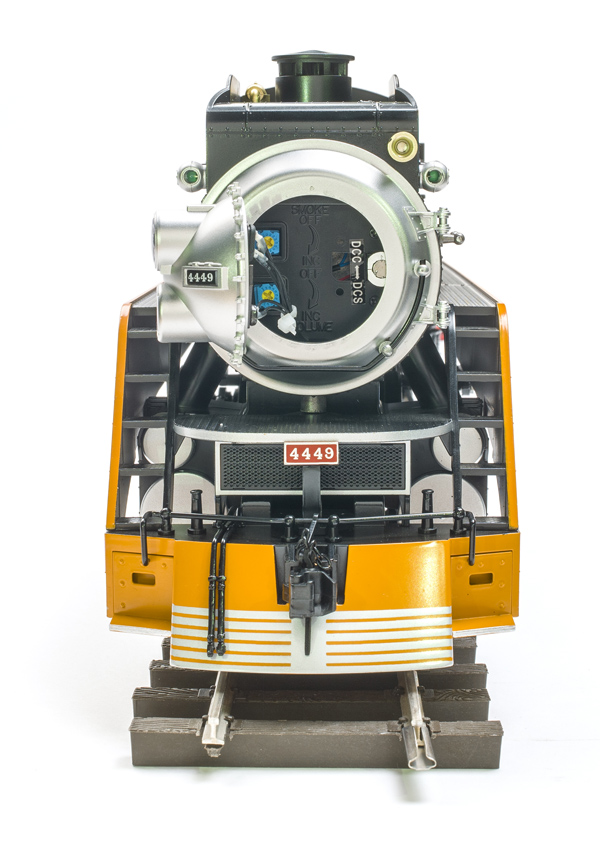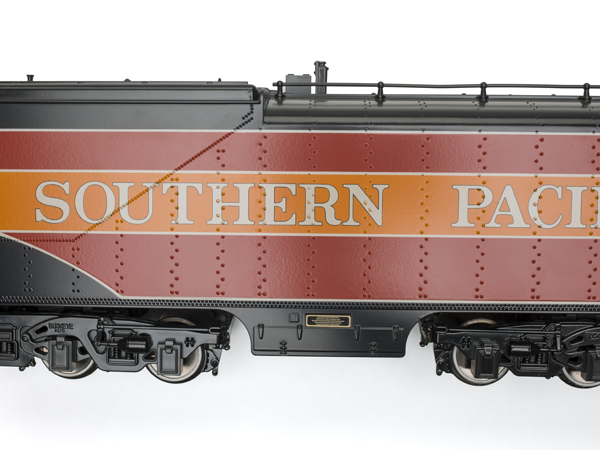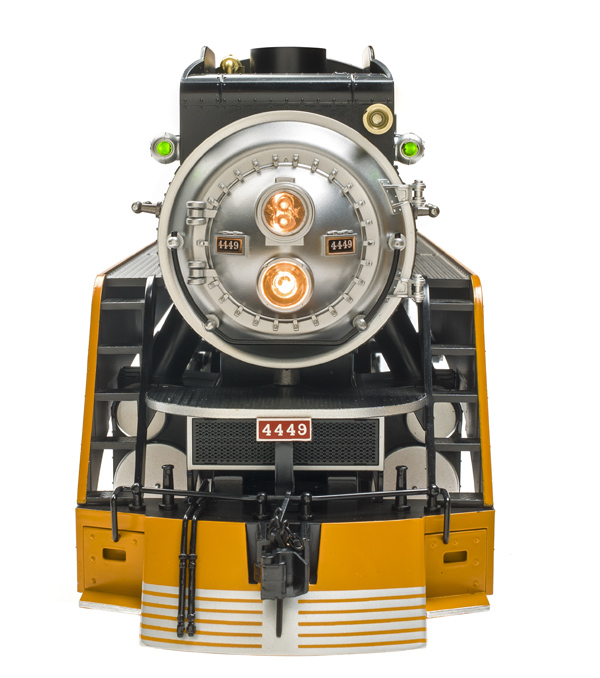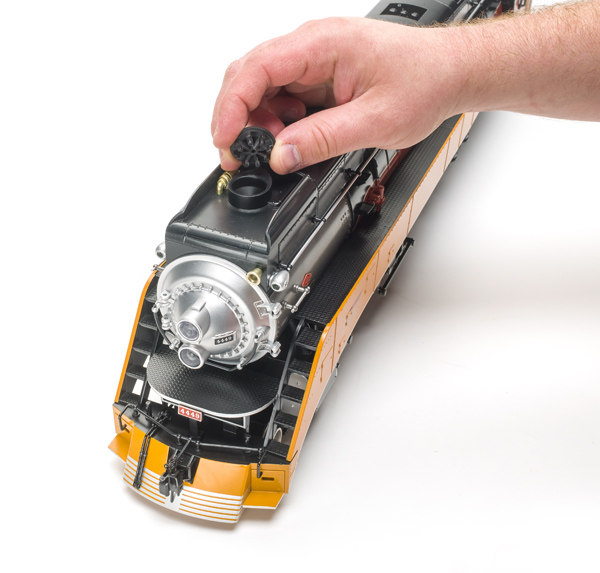MTH Electric Trains
7020 Columbia Gateway Dr.
Columbia, MD 21046-1532
www.mthtrains.com
Price: $1,199.95
Era: 1941 to 2002 (varies with scheme)
Road names: Southern Pacific (Daylight scheme with large or small lettering on tender in two road numbers each and black), American Freedom Train, BNSF Ry., and Western Pacific. One number per scheme unless noted.
Features:
Minimum radius: 4′
Measures: 43″ x 4 5/16″ x 6 1/4″
Weight: 13 pounds, 12 ounces
Flywheel-equipped motor
Onboard DCC receiver
Constant voltage headlight and operating tender backup light
Wireless drawbar
The prototype. Southern Pacific’s class GS-4 4-8-4 steam locomotives were built by the Lima Locomotive Works in 1941 and 1942. The 28 engines, numbered 4430 through 4457, were oil burners that featured all-weather cabs. The easily recognizable engines were used on passenger trains until they were eventually displaced by diesel locomotives.
The class GS-4 engines (GS standing for “Golden State” or “General Service,” depending on sources) were retired between 1956 and 1958. The sole survivor was no. 4449, which was donated to the city of Portland, Ore., in April 1958. It sat on display until December 1974, when it was restored to operating condition. The 4449 re-entered service in April 1975 in a patriotic paint scheme, pulling the American Freedom Train throughout the United States to celebrate the nation’s bicentennial.
The model. Our sample is decorated as SP no. 4449 in the distinctive red-and-orange Daylight paint scheme with large lettering on the tender. The paint on the locomotive is smooth and evenly applied with opaque striping and the Daylight logo on the skirting above the pilot truck. Both sides of the smokebox have a separately applied Lima builder’s plate and Southern Pacific equipment trust plate. The engineer’s side also has a manufacturing plate for The Superheater Co. The lettering on all of the plates is legible under magnification.
The polycarbonate locomotive body features a mix of molded and separately applied details. Freestanding details include the turbogenerators, safety valves, whistle, air horn (the bell part of it), handrails, and steps. The molded doors, seams, rivets, and washout plugs are crisply defined. The walkways feature a diamond-tread pattern.
The Boxpok drivers have a star in the center, which indicated spring pad lubrication on the full-size engines. A pair of cross compound air compressors are correctly located above the drivers on the fireman’s side.
Not to be overlooked is the illuminated cab interior, which features factory-painted and installed engineer and fireman figures and a detailed backhead with gauges. The cab exterior features a positionable roof vent and side windows, separate wind deflectors, and wire grab irons.
The locomotive is connected to the tender via a wireless drawbar. This is a printed-circuit (PC) board attached to the locomotive with a screw. On each end of the PC board is an upward facing 10-pin plug. One plug is factory-connected to the engine. The other pin is connected by the modeler to a socket on the underbody of the tender, just ahead of the front truck.
The tender has a one-piece polycarbonate body. On our sample, the red and orange paint on the fireman’s side has moderate orange peel texturing. The striping and lettering are opaque, and the black trim around the “Southern Pacific” lettering is in register. There were a few small voids in the lettering over the rivet heads on the tender.
Like the locomotive, the tender features a mix of molded and separate parts. The front of the tender is the oil tank, which has a separate, non-positionable fill cover, a freestanding vent pipe, and raised molded details.
Making up the balance of the tender is the water compartment, with four separate water hatches. The taller box, where the rear marker lights were stored on the full-size tender, is molded. The ladders and handrails are separate factory-applied parts. Both sides of the tender have an equipment trust plate.
The body is secured to the plastic underframe with six Phillips-head screws. Inside is a downward-facing speaker with a cardboard enclosure, a steel weight, and a
light-emitting diode (LED) backup light attached to an L-shaped metal bracket.
Sideframes of the six-wheel Buckeye trucks feature raised BUCKEYE PAT’D lettering. A length of painted brass chain is screw-fastened to the corner of both trucks. The other end of the chain is connected to the underbody. The metal wheels are chemically blackened with the tires painted white.
At the controls. The GS-4 features a Digital Command Control (DCC) receiver and an onboard DCC/Digital Command System (DCS) decoder with Proto-Sound 3.0. The chuffing ProtoSmoke system is synchronized to the four-chuffs-per-turn wheel revolution. Controls for the volume and smoke intensity, as well as the DCC/DCS selector switch, are located behind the smokebox door.
A variety of lighting features further enhance the model. The GS-4 has a constant voltage headlight; a dimmer function for Rule 17 lighting effects; and an operating Mars light on the smokebox front, class lights on the smokebox sides, and a backup light on the rear of the tender. The number boxes also illuminate. On our sample, the number boxes display 2, indicating the locomotive is pulling train no. 2, the eastbound Sunset Limited, which operated between Los Angeles and New Orleans.
The 4-8-4 is equipped with a remote-controlled Proto-Coupler on the tender.
A mounting pad for installing a Kadee coupler (sold separately) is supplied with the model, as are standard knuckle and hook-and-loop couplers. The scale-sized
coupler on the front of the locomotive is non-functioning.
To the test track. The GS-4 matches or is within scale inches of prototype drawings published the in the April 1972 issue of our sister magazine Model Railroader. The GS-4 tipped the warehouse shipping scale at 13.75 pounds. With an impressive drawbar pull of 70 ounces, the 4-8-4 can haul 70 free-rolling cars on straight and level track. That number would likely increase if the two traction tires (included) were installed.
A capacitor keeps the engine running over dirty rail and dead spots for up to 10 seconds.
The locomotive will operate on alternating current (AC), direct current (DC), DCC, and DCS. I started by testing the GS-4 in DC using an LGB Jumbo. The lights and sounds came on at 7.5V. The locomotive started moving smoothly at around 11V at a scale 3.5 scale mph. The 4-8-4 achieved at top speed of 79 scale mph at 22V. The full-size GS-4s maximum speed was 110 mph.
Engine and idle sounds, brake squeal, and the smoke unit are the only effects available in DC. Also note that the engine won’t move if more than 9V DC is applied at startup. Build up the voltage gradually when using DC.
I then tested the model with an MTH DCS system, which gave access to the various Proto-Sound 3.0 sound and lighting effects and activated the Proto-Coupler. The model ran smoothly at 1 smph, and achieved a top speed of 120 smph. The sound system is quite robust. Several colleagues – both railfans and non-railfans – poked their heads in the workshop to locate the source. I watched footage of the 1:1 scale no. 4449 for comparison, and the smoke unit puts out a realistic amount of smoke.
Southern Pacific’s GS-4 4-8-4 steam locomotives were certainly some of the most recognizable engines of the steam era. MTH has done a great job capturing the looks, lights, and sounds of the semi-streamlined locomotive in 1:32 scale.





















As a fellow model railroader and Garden Railways reviewer from the 1990s I have high praise for Cody’s thorough review.
Both his detail about the model and the prototype are very impressive.
MTH has produced fantastic 1:32 Scale train models over the last 20 years which continue to give me great joy as an operator on Large Scale layouts.
Sincerely, Gary Raymond